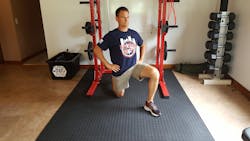Health & Wellness: 5 Exercises to Prevent Back Injuries
Last week, my crew and I were at the scene of an extrication, using a background to remove a patient from a vehicle. I was at the foot of the board and was following the lead of the those in the front. As we twisted and stepped, my foot slipped off the curb and I tweaked my back. I was still able to maintain enough control to get the patient to the cot, but my back was already starting to tighten.
This is a very common occurrence on the fire and rescue ground. Due to the nature of our jobs, firefighters, EMTs and paramedics are at increased risk of back injury compared to other professions. According to the International Association of Fire Fighters (IAFF), sprains and strains routinely account for approximately 50 percent of all line-of-duty injuries, and back injuries account for approximately 50 percent of all line-of-duty injury retirements each year. These back injuries result in significant lost time, medical expense and obviously have a huge impact on daily living.
Why are firefighters more susceptible to injury?
To uncover the reasons and rationale of firefighter back injuries, I consulted with Luis Rivera, an athletic trainer/physical therapist and CEO/cofounder of Tactical Athlete Health and Performance Institute in Milwaukee, WI.
“The main causes of work-related back injuries among firefighters include repetitive lifting of heavy objects, awkward positions and postures, and forceful and repetitive exertion in unstable plains,” he says. “Musculoskeletal disorders of the spine can be the result of an acute event, but are usually due to chronic exposures over time. The risk of musculoskeletal disorders of the spine increases with the frequency, duration and intensity of exposures.”
These unstable and unpredictable situations will always have the potential for injury—and this cannot be eliminated. But there are some ways that we can minimize our risk.
Preventing back injuries
Many common workplace interventions that target musculoskeletal disorders, such as redesigning workstations or reducing workload, are obviously not applicable to the fire service. Teaching proper lifting techniques can be helpful but are not always realistic due to the nature of the job.
Rivera explains that the number one way to prevent back injury is to exercise the body properly: “A proper exercise program that incorporates applicable movements to the fireground and addresses the musculoskeletal demands that firefighters face is the best prevention to back injuries.”
In order to determine which exercises are best to minimize the risk of back injury, Rivera and I analyzed the data and the demands of the job, as well as a variety of sources, a process that ultimately led us to the following exercises. We suggest incorporating these exercises into your workouts or completing them together as one workout.
As with any exercise, if not done with proper technique, it will be ineffective and could lead to injury. In the case of these exercises, the order in which they are performed is very important as well. One builds on the next. For example, it is imperative to stretch the tight muscles first, followed by working the weak muscles to get your body to operate efficiently. Stability balls, bands and progressing to single-leg movements are ways to make these exercises more difficult as you continually challenge your body to improve.
1. Half-Kneeling Hip Flexor Stretch
Always try to start workouts with this exercise. The hip flexors are a group of muscles that connect your femur (thigh bone) to your pelvis (hip bone) and lower back. Due to the nature of work firefighters do—climbing, lifting, crawling and sitting—these muscle groups tend to be tight and inflexible. Rivera explains that this exercise is pivotal to perform first in the series. “Tight hips inhibit your glutes from firing, which puts a lot of strain on the back,” he says. “Stretching the hip flexor helps to activate the glutes and opens the hips.”
2. Bird Dog
There can be multiple underlying factors related to low back injuries, but Rivera states that, “deconditioned muscles of the core and trunk are strongly associated with low back injury.” The Bird Dog exercise was chosen for this list because it activates the entire core: abs, lower back and butt muscles. It requires a little coordination, but you’ll master it after a few reps.
3. Dead Bugs
This exercise has been popular in athletic settings for many years and should be integrated into every firefighter’s workout. It gets its funny name because when you perform it, you look like a dead bug lying on its back with its legs in the air. “Often athletes cannot raise their arms overhead or move their hips without engaging or arching the muscles of the lower back, which places undo stress on the spine,” Rivera explains. “The Dead Bug fixes these issues by teaching you to isolate movement at the hips and shoulders without moving your spine.” Improving this movement pattern is important because it protects your spine from movements it was not designed to handle.
4. Glute Bridging
The glutes are one of the most overlooked muscle groups of the core. Individuals with weak glutes are more susceptible to back injury because the muscles of the low back must compensate. This compensation can lead to pain and injury if not addressed. Rivera explains: “The muscles of the glutes (gluteus maximus, medius and minimus) play a key role in helping take stress off the spine during multiplanar movements. These muscles help control movements of the torso, pelvis, hips and legs, so it is imperative that they are working properly.”
5. Side Plank
A well-rounded core routine should include exercises that work the front, sides (obliques) and back as well as the hips and pelvis. The Side Plank is a unique exercise because it targets the obliques and deep muscles of the glutes whereas most core exercises focus on either the front or the back. “Working the oblique muscles is very important when preventing back injury,” Rivera says. “Most acute back injuries in firefighters are a result of some type of twisting motion, strong obliques and glutes can help control movement through the transverse plane of movement and reduce chances of injury.”
In sum
Over time, performing these core exercises consistently can have enormous benefits. Try to incorporate these exercises with every shift you work or before you perform your regular workouts. When incorporated as part of a daily exercise routine, they can yield a lifetime benefit of improved posture, a healthier spine, a prolonged career and a more active retirement. Remember preventing a back injury is much easier than treating one.
References
Axe, J. “The Top 5 Exercises to Strengthen Your Core to Prevent Low Back Pain.” https://draxe.com/the-top-5-exercises-to-strengthen-your-core-to-prevent-low-back-pain.
International Association of Fire Firefighters. “Back Injuries and the Fire Fighter.” iaff.org/hs/resi/backpain.asp.
Liao, S. “5 Best Moves to Prevent and Ease Back Pain.” Prevention. February 2016. prevention.com/fitness/5-best-moves-to-prevent-and-ease-back-pain.
McCall, P. “5 Exercises to Flatten Your Stomach and Reduce Low-Back Pain.” The American Council on Exercise. acefitness.org/blog/3092/5-exercises-to-flatten-your-stomach-and-reduce-low-back-pain.
National Fire Protection Association. “Firefighter injuries in the United States – 2015.” October 2016: http://www.nfpa.org/news-and-research/fire-statistics-and-reports/fire-statistics/the-fire-service/fatalities-and-injuries/firefighter-injuries-in-the-united-states.
Steffens, D., Maher, C. Pereira, L., et al. “Prevention of Low Back Pain: A Systematic Review and Meta-analysis.” JAMA Internal Medicine. 2016;176(2):199–208. jamanetwork.com/journals/jamainternalmedicine/fullarticle/2481158.
Syuki, B. “5 Best Ab Exercises for People with Lower Back Pain.” Care2. June 20, 2016.
care2.com/greenliving/5-best-ab-exercises-for-people-with-lower-back-pain.html.
About the Author
Aaron Zamzow
Aaron Zamzow is a firefighter/training officer for Madison, WI, Fire Department. He holds a bachelor’s degree in health/wellness and has 20 years of experience as a fitness trainer. He created Fire Rescue Fitness and authors programs that are aimed at getting fire rescue athletes fit for duty.

